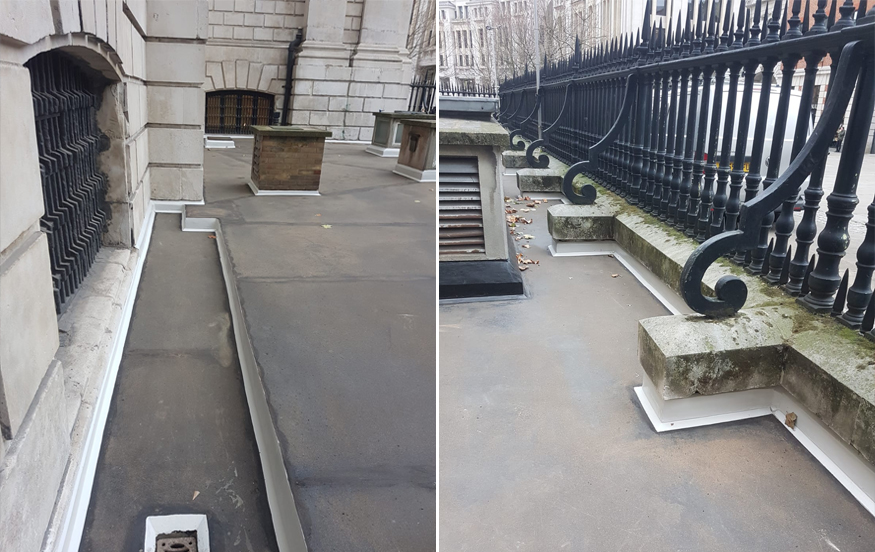The sustainability of roofing systems is becoming increasingly important amongst architects, specifiers, facilities managers and building owners.
Back in 2008, the Mastic Asphalt Council (MAC) made history as the first industry in the world to achieve the CarbonZero standard. Since then mastic asphalt has offset thousands of tonnes of carbon dioxide – underlining its status as a green waterproofing material. Mastic asphalt can help specifiers to achieve the highest BREEAM rating possible as mastic asphalt can be integral in any building design where an A+ rating is required.
Although mastic asphalt is typically known for its durability, it is increasingly being specified for roofing projects where green credentials are taken into consideration. When mastic asphalt has reached the end of its useful life, it can be recycled or used as roof screed. The Building Research Establishment (BRE) has officially stated that asphalt roofing is capable of lasting 50-60 years, but MAC has many examples well in excess of this.
One project which perfectly highlights the durability and recyclable properties of mastic asphalt is London’s St Paul’s Cathedral – itself one of the most renowned applications of mastic asphalt. St Paul’s Cathedral, with its world famous dome, is an iconic feature of the London skyline. The largest Cathedral in England, it is the masterpiece of Britain’s most famous architect Sir Christopher Wren.
Mastic asphalt was first laid in 1906 on the Stone Gallery that circles the Cathedral dome and it provided a remarkable 111 years’ weatherproof protection before it required refurbishment by MAC member Sussex Asphalte.
This project was deemed so successful that it won the accolade of Project of the Year at the MAC Annual Awards in 2018. Earlier that year, Sussex Asphalte and IKO PLC celebrated another award as it was selected as the Best Mastic Asphalt Project at the NFRC (National Federation of Roofing Contractors) Annual Awards.
When the mastic asphalt on the Stone Gallery was renewed, approximately 20 tonnes of the original mastic asphalt was saved and stored on-site to allow it to be re-used again in the future. Just nine months later it was re-melted, sieved and used again by Sussex Asphalte for a further mastic asphalt waterproofing project at St Paul’s Cathedral – this time on the North Courtyard. The underlying workshops and storage facilities were affected by water ingress, so it was necessary to waterproof the 500m2area, again with mastic asphalt.
The recycled mastic asphalt was used as the first layer of waterproofing to the North Courtyard. This then had a 15mm recreational duty top coat of mastic asphalt with added granite applied. The intricate nature of the courtyard with numerous protrusions, lights, changes in height and directions created a challenge to ensure all falls were adequate and no ponded water, as this is a busy storage yard for the Cathedral. There were many tight, intricate areas with changes in direction to upstands. Furthermore, the existing asphalt was difficult to remove and the awkward nature of the space made it challenging to ensure straight lines and high quality workmanship.
Where previous design details were not adequate, Sussex Asphalte – in conjunction with the Clerk of Works at St Paul’s Cathedral – raised upstand heights and improved falls to ensure there was no ponding. All three of Sussex Asphalte’s current mastic asphalt apprentices who attend New City College Hackney gained vital knowledge and skills on this landmark project, under the watchful eye of Sussex Asphalte’s senior charge hand who himself attended New City College Hackney some 15 years ago through Sussex Asphalte.
The project was carried out during the lead-up to the busy Christmas period and operatives had to contend with adverse weather and plummeting temperatures, maintaining watertight areas at all times to enable works to continue below unhindered. Disruption was kept to an absolute minimum as thousands of visitors from all around the world visit the Cathedral every week. Despite the testing weather conditions and busy nature of the site, the project was delivered a week early with a saving of £11,000 for the client.
This is a superb example of mastic asphalt once again being used on one of the UK’s most iconic heritage structures and being recycled to conserve this important building. Not only has mastic asphalt provided 111 years’ of weatherproof protection on the Stone Gallery, but it has also been re-used again for the application on the North Courtyard, confirming its durability, performance and environmental credentials. This latest installation on the North Courtyard was carried out in accordance with BS 8212:1998 and the same high level of workmanship as the Stone Gallery project. Through excellent project management, works were completed ahead of schedule.
This article featured in the September Edition of RCi magazine – click here to take a look.

